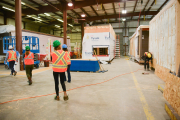The Alberta budget is released tomorrow and includes a price on carbon that is now the reality in Canada. The advice from economists on all sides is consistent — a comprehensive climate policy includes a mechanism that puts a price on carbon.
Alberta’s new carbon levy is not well understood yet and misinformation is spreading quickly. In this blog we describe Alberta's approach to carbon pricing and explain how the majority of Albertans will pay nothing additional on gasoline or heating costs. Most people could even come out ahead financially and yet they still have a clear incentive to reduce their GHG emissions.
The carbon levy won’t cost most of us more
With the introduction of the carbon levy to cover transport fuel (i.e., gasoline) and heating fuels used in the home, there is a lot of misinformation about the impact on average Albertans. People are claiming this move will cost households an extra $500 a year — a scary prospect. This makes for good headlines but its clear from the Climate Leadership Panel (CLP) report that it’s nothing more than hot air.
Economists agree, putting a price on carbon and letting the market find ways to reduce emissions is highly effective. The money to be collected won’t just disappear. The CLP recommends a portion be used to offset the impacts on low to middle-income households by providing them with a twice a year consumer rebate. Estimates from a recent Ecofiscal report show doing so would take less than 10 per cent of the revenue collected.
The majority of Albertans will pay nothing additional or even come out ahead
Under the CLP plan, households would be given a rebate that covers the “average” cost of the carbon levy. If consumers reduce their emissions — turn down the heat when no one is home, choose more fuel efficient cars, use public transit, walk, bike, take advantage of coming energy efficiency programs — they can reduce their “actual” cost below the “average.” Add to that the direct savings from using less energy and you get extra cash in your pocket.
Low-income consumers typically use less energy than the rest of the population meaning the average rebate will more than cover the carbon costs they pay.
High-income earners will now have an incentive to invest in reducing their emissions to reduce their costs.
Consumers do respond and reduce
Many people are claiming emissions are fixed because people cannot change behavior to reduce emissions and a carbon price won’t make them go down. The reality is there are examples from other jurisdictions that show people do respond to a carbon price by making changes to lower costs now and to avoid repeatedly paying a price on carbon over the longer term. Limiting the rebate to the additional cost faced by low and middle-income consumers ensures additional money needed to make investments in reducing emissions is available. These revenues can be used to support energy efficiency, renewable energy, and clean technology. It can also be used as transitional support for small businesses, trade exposed industries, Indigenous communities, and people working in the coal industry. Returning all of the money in the form of tax reductions would not generate the funds needed to accomplish these goals.
The carbon levy and rebate system will protect Albertans from extra costs for gasoline and heating — and actually leave them coming out ahead. It turns what could be a cost into a savings for consumers while incentivizing the emissions reductions we need to see in the province.









